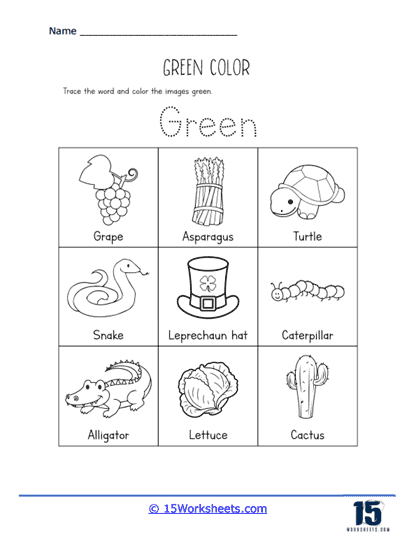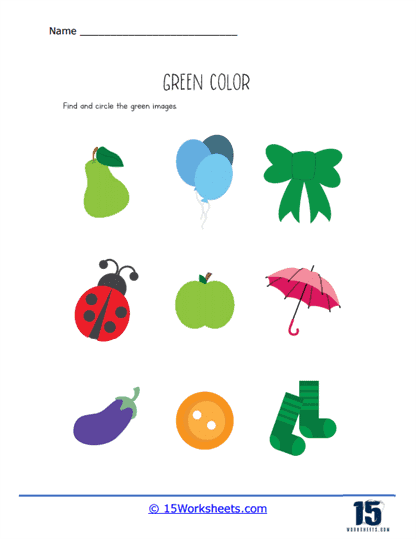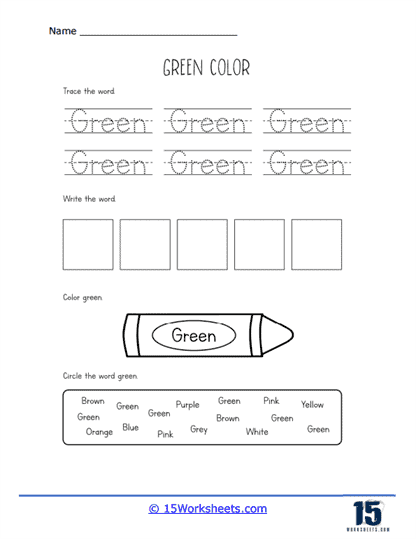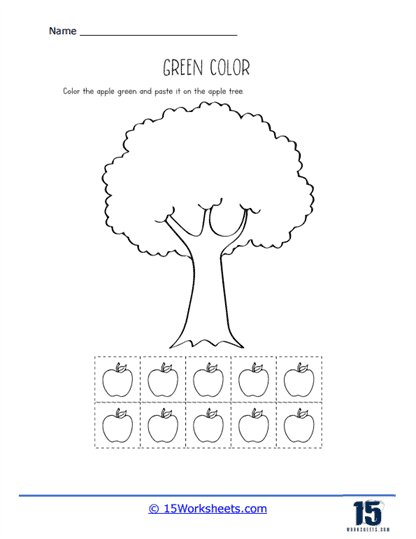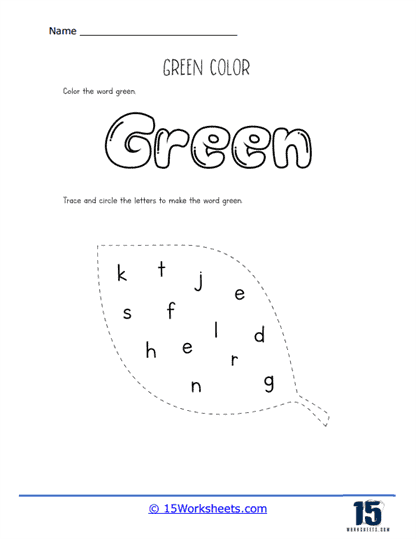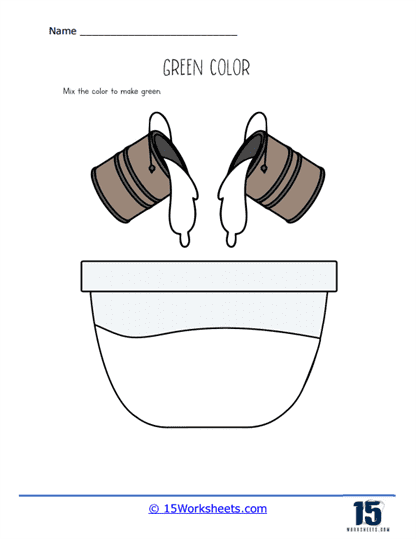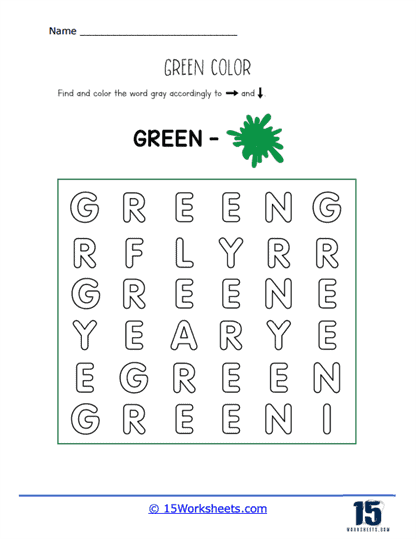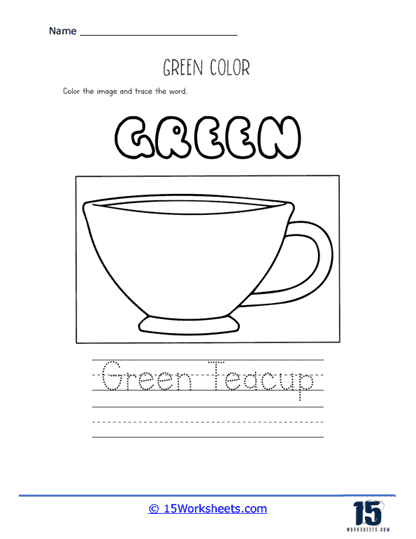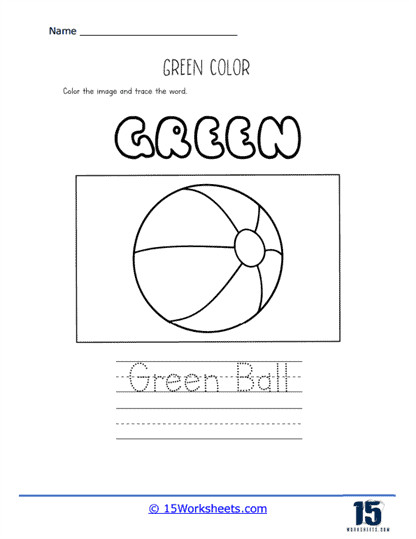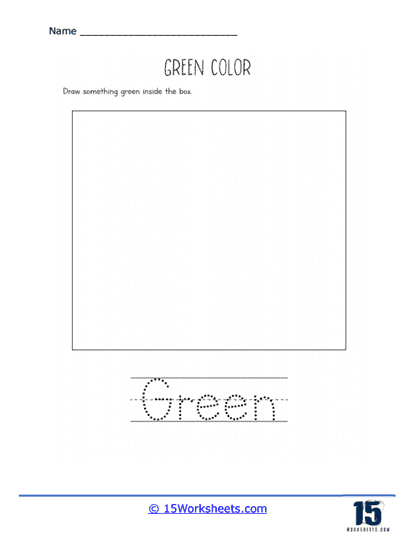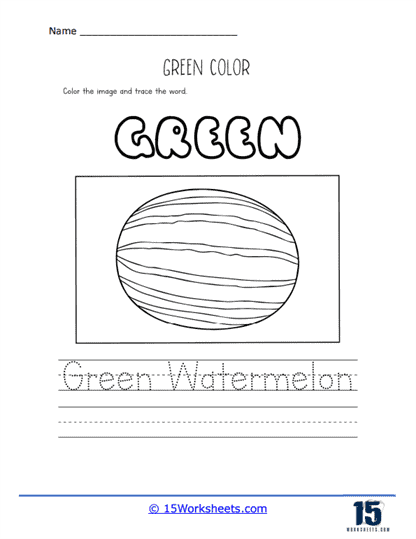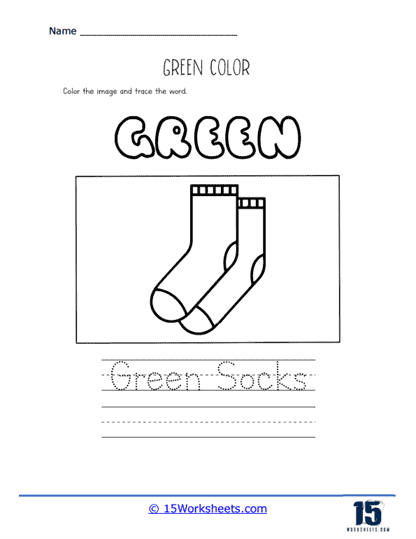Green Worksheets
All About These 15 Worksheets
Immerse your young learners in the vibrant and refreshing world of green with this thoughtfully crafted series of Kindergarten worksheets. Carefully designed to introduce children to the concept of colors, this collection focuses specifically on the color green, helping young minds grasp its essence in a fun and engaging way. These worksheets go beyond simple color recognition; they are a tool for nurturing creativity, building vocabulary, and fostering a deeper understanding of the world through color. Through an assortment of interactive exercises, students not only learn about green but also sharpen their cognitive abilities and critical thinking skills.
Each worksheet is tailored to capture the natural curiosity of kindergarteners, inviting them to explore the many facets of green through a range of activities. These activities include identifying objects that are green, tracing the word “green,” and even learning about items, plants, and symbols commonly associated with this color. By doing so, children will not only recognize the color itself but also develop an understanding of how it appears in their everyday lives. Whether it’s the green of a tree’s leaves, the grass under their feet, or the skin of a crisp apple, the color green begins to hold more meaning as students connect it to the world around them.
The process of identifying and coloring green objects is more than just an exercise in creativity; it is a crucial building block in developing a child’s visual discrimination skills. As they discern which objects should be colored green, students strengthen their ability to distinguish between various hues, shapes, and patterns. This skill is foundational for other areas of learning, including reading and mathematics, where recognizing differences in symbols, letters, and numbers is essential. With each stroke of green crayon or marker, children reinforce their understanding of the color while enhancing their capacity to notice and analyze the visual details in their environment.
In addition to color identification, tracing exercises provide a valuable opportunity for fine motor skill development. Young learners will engage in tracing the word “green,” helping them not only to recognize the letters and their formation but also to strengthen their hand-eye coordination. This task goes beyond simply writing the word-it encourages students to become comfortable with the mechanics of writing, paving the way for future literacy. As they progress from tracing to independently writing the word, they build confidence in their abilities, taking pride in mastering new skills that will serve them throughout their education.
A key feature of this worksheet series is its focus on expanding vocabulary through an exploration of objects and symbols connected to the color green. Children will learn about nature, animals, and everyday items that share this vibrant hue. Through this process, their vocabulary will grow as they associate new words with familiar concepts. For instance, when they color a frog, a green apple, or a leafy tree, they are not just learning about color-they are engaging in a rich sensory experience that broadens their language skills. This connection between visual learning and language acquisition is instrumental in helping children articulate their thoughts and observations with clarity and creativity.
But this series doesn’t stop at mere color recognition and vocabulary enhancement. It invites children to think critically about the associations they make with the color green. Green can symbolize nature, growth, renewal, and even feelings like calmness or envy. As children explore these themes, they begin to understand the deeper meanings that colors can convey, laying the groundwork for emotional intelligence and artistic expression. By engaging in activities that require them to make choices, solve problems, and create art, they are not just passive learners-they are active participants in their own educational journey.
These worksheets also serve as an invaluable resource for cultivating fine motor skills and cognitive development. Activities that involve drawing, coloring, and tracing require precision, focus, and patience, all of which are crucial for developing control over small hand movements. This, in turn, supports the growth of skills necessary for writing, cutting with scissors, and other everyday tasks. The hands-on nature of these activities encourages young learners to become more confident in their abilities, instilling a sense of independence and pride in their accomplishments.
Through this series of green-themed worksheets, children will also foster an appreciation for the role that color plays in art and creativity. By exploring different shades of green and creating their own artwork, students will gain a deeper appreciation for the visual world. This experience encourages self-expression and imaginative thinking, allowing them to experiment with colors and ideas in a safe, structured environment. Whether they are drawing a lush green forest or simply coloring a favorite green object, the act of creating becomes an outlet for their emotions, thoughts, and creativity.
What are the Properties and Meanings of the Color Green?
Green is a fascinating color with various properties, cultural meanings, and applications. As a secondary color in both the RGB and RYB color models, green is created by combining blue and yellow.
The Cultural Significance
Green is often associated with nature, growth, renewal, and fertility. It symbolizes life, balance, and harmony. In some cultures, green represents good luck, prosperity, and wealth. However, it can also be linked to envy, jealousy, and inexperience. Green’s significance varies across cultures and religions. For example, in Islam, green is considered a sacred color, symbolizing life and paradise. In ancient Egypt, green represented the hope of new life and rebirth, and in ancient China, green jade was believed to bring good fortune.
Art and Design
Throughout history, green has been widely used in art and design. Various shades of green have been created using different pigments, such as malachite, verdigris, and viridian. Green pigments were used in ancient Roman frescoes and medieval illuminated manuscripts. In the Renaissance, artists like Leonardo da Vinci and Michelangelo employed green pigments in their works. Today, green is used in a wide range of applications, from interior design and fashion to graphic design and product packaging.
In Nature
Green is found in various natural objects and living beings. It is the most common color in the plant world due to chlorophyll, the pigment responsible for photosynthesis. Green is also found in certain minerals, such as malachite, emerald, and jade. Some animals, like frogs, snakes, and insects, possess green coloration for camouflage purposes.
Science and Technology
In science, green pigments can be found in nature, and green dyes have been synthesized for various applications. Green is also used in technology; green LEDs and lasers have been developed for uses in electronics, communication, and entertainment. Green screens are employed in film and television production for chroma key compositing, allowing the replacement of the green background with other images or footage.
Idioms and Expressions
Numerous idioms and expressions in the English language feature the color green, such as “green thumb” (referring to a talent for gardening), “green with envy” (feeling jealous), and “greenhorn” (a newcomer or inexperienced person).
In summary, green is a multifaceted and captivating color with diverse symbolic meanings, cultural significance, and uses in art, design, fashion, science, and technology. Its prevalence in nature and association with growth, renewal, and balance make it an essential and influential color in our lives.

